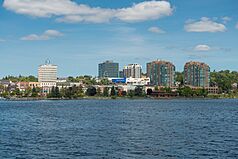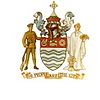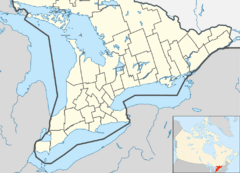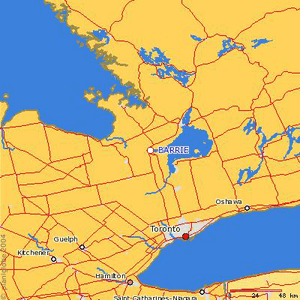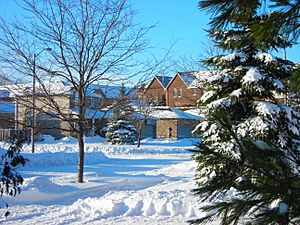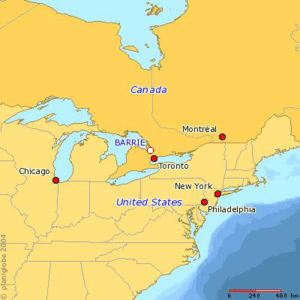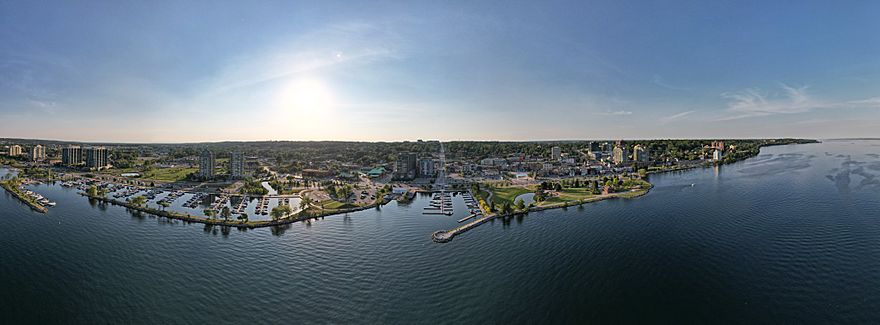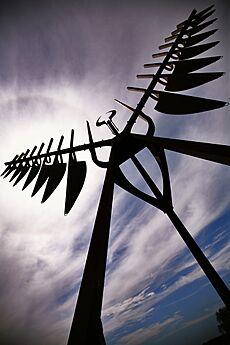Barrie facts for kids
Quick facts for kids
Barrie
|
|||||
|---|---|---|---|---|---|
| City of Barrie | |||||
|
From top, left to right: Downtown Barrie, MacLaren Art Centre, the CKVR-TV Tower, the Spirit Catcher, Sadlon Arena
|
|||||
|
|||||
| Motto(s):
The People are the City
|
|||||
| Country | Canada | ||||
| Province | Ontario | ||||
| County | Simcoe (independent) | ||||
| First settled | End of War of 1812 | ||||
| Established | 1854 (village) | ||||
| Established | 1870 (town) | ||||
| Established | 1959 (city) | ||||
| Named for | Sir Robert Barrie | ||||
| Wards |
10 wards
Ward 1 – Councillor C. Riepma
Ward 2 – Councillor K. Aylwin Ward 3 – Councillor A. Kungl Ward 4 – Councillor B. Ward Ward 5 – Councillor R. Thomson Ward 6 – Councillor N. Harris Ward 7 – Councillor G. Harvey Ward 8 – Councillor J. Harris Ward 9 – Councillor S. Morales Ward 10 – Councillor M. McCann |
||||
| Area | |||||
| • City (single-tier) | 99.01 km2 (38.23 sq mi) | ||||
| • Urban | 171.53 km2 (66.23 sq mi) | ||||
| • Metro | 898.02 km2 (346.73 sq mi) | ||||
| Elevation | 252 m (827 ft) | ||||
| Population
(2021)
|
|||||
| • City (single-tier) | 147,829 | ||||
| • Density | 1,493.1/km2 (3,867/sq mi) | ||||
| • Urban | 172,657 | ||||
| • Urban density | 918.27/km2 (2,378.3/sq mi) | ||||
| • Metro | 212,667 | ||||
| • Metro density | 219.4/km2 (568/sq mi) | ||||
| Time zone | UTC−05:00 (EST) | ||||
| • Summer (DST) | UTC−04:00 (EDT) | ||||
| Forward Sortation Area |
L4M to L4N, L9J, L9X
|
||||
| Area codes | 705, 249, and 683 | ||||
| Highways | Highway 90 |
||||
| GNBC Code | FAFFD | ||||
| GDP (Barrie CMA) | CA$8.6 billion (2020) | ||||
| GDP per capita (Barrie CMA) | CA,735 (2016) | ||||
Barrie is a city in Central Ontario, Canada, about 90 kilometres (56 mi) north of Toronto. The city is within Simcoe County and located along the shores of Kempenfelt Bay. Although it is physically in the county, Barrie is politically independent. The city is part of the extended urban area in southern Ontario known as the Greater Golden Horseshoe. As of the 2021 census, the city's population was 147,829, while the census metropolitan area had a population of 212,667 residents.
The area was first settled during the War of 1812 as a supply depot for British forces, and Barrie was named after Sir Robert Barrie. The city has grown significantly in recent decades due to the emergence of the technology industry. It is connected to the Greater Golden Horseshoe by Ontario Highway 400 and GO Transit. Significant sectors of the city's diversified economy include education, healthcare, information technology and manufacturing.
Contents
History
At its inception, Barrie was an establishment of houses and warehouses at the foot of the Nine Mile Portage from Kempenfelt Bay to Fort Willow, an aboriginal transportation route that existed centuries before Europeans came to Simcoe County. The portage linked Kempenfelt Bay through Willow Creek, connecting Lake Simcoe to the Nottawasaga River which flows into Georgian Bay off Lake Huron.
Barrie played an integral role in the War of 1812. During the War, the city became a supply depot for British forces, and in addition, the Nine Mile Portage was adopted by the British Military as a key piece of their supply line which provided a strategic path for communication, personnel, and vital supplies and equipment to and from Fort Willow and Georgian Bay / Lake Huron. Today, the Nine Mile Portage is marked by signs along roads in Barrie and in Springwater Township. You can follow the scenic path from Memorial Square all the way to Fort Willow.
The city was named in 1833 after Sir Robert Barrie, who was in charge of the naval forces in Canada and frequently commanded forces through the city and along the Nine Mile Portage.
Barrie was also the final destination for one branch of the Underground Railroad. In the mid-19th century, this network of secret routes allowed many American slaves to enter Barrie and the surrounding area. This contributed to the development (and name) of nearby Shanty Bay.
By 1869, Barrie was the county seat of Simcoe in the Township of Vespra with a population 3,000. It was a station of the Northern Railway. It was pleasantly situated on Kempenfelt Bay, Lake Simcoe. There were steamers to the Muskoka Territory Orillia & Stages to Penetanguishene.
During World War II, the Royal Canadian Navy named a Flower class corvette HMCS Barrie.
On 7 September 1977, a private aircraft dropped altitude to 500 feet (150 m) in dense fog, struck the 1,000-foot (300 m) CKVR-TV tower, killing all five on the plane and destroying the tower and antenna. The station's 225-foot (69 m) auxiliary tower was also destroyed and there was some damage to the main studio. CKVR were back on the air using a temporary 400-foot tower and reduced power of 40,000 watts at 8:55am on 19 September. The new 1,000-foot (300 m) tower was rebuilt in 1978.
On 31 May 1985, an F4 tornado struck Barrie. It was one of the most violent and deadliest tornadoes in Canadian history.
On 12–13 June 1987, a sculpture called Spirit Catcher by Ron Baird was moved to Barrie from Vancouver, British Columbia, where it had been exhibited as part of Expo '86. The sculpture was erected permanently at the foot of Maple Avenue on the shore of Kempenfelt Bay. However, with the re-development along the waterfront/Lakeshore Drive, the city is considering moving the Spirit Catcher to the gravel outcropping at the foot of Bayfield Street.
Barrie's Park Place (formerly Molson Park) was chosen to host Live 8 Canada on 2 July 2005. The success of the concert contributed to the resistance to a plan to convert the concert area to a commercial district. However, the stage, buildings and many of the trees on site have been destroyed since construction of the Park Place commercial district has begun.
An explosion in the Royal Thai restaurant, housed in the landmark Wellington Hotel, at the historic Five Points intersection in Barrie's downtown core occurred at 11:20 PM on 6 December 2007. The fire quickly spread to several neighbouring buildings. Firefighters battled the blaze well into the following morning, requiring assistance from other Simcoe County fire services. Officials estimate the damages to be in the millions. The Wellington Hotel building collapsed. It was over one hundred years old. On 17 February 2008, two people were charged in connection with the fire, after the Ontario Fire Marshal's office concluded the explosion and fire were the result of arson.
Geography
Barrie is located in the central portion of Southern Ontario, approximately 90 km (56 mi) north of Toronto within the Greater Golden Horseshoe subregion. It is accessible via Highways 26, 400, and 11.
Barrie's historic downtown area is situated in a distinct curved or wrapped valley, surrounding the western edge of Kempenfelt Bay (part of Lake Simcoe. Terrain is generally flat near the city's centre. Moving up the valley slopes toward the city's north and south ends, the terrain can be rather steep in some areas.
The city does not have any major rivers within its limits, but does have numerous creeks and streams, most of which empty into Kempenfelt Bay.
Communities
- Letitia Heights
- Cundles
- Ardagh Bluffs
- Eastview
- Holly
- Downtown
- Painswick
- Allandale
- Kingswood
Expansion
Barrie has been designated an Urban Growth Centre by the Province of Ontario (Places to Grow Simcoe Area, 2009). Its population growth, largely due to its emergence as a bedroom community for Toronto, has given rise to the development of numerous subdivisions on the southern side of the city. Barrie successfully annexed 2,293 acres (9.28 km2) of land from the neighbouring Town of Innisfil to the south and southeast on 1 January 2010. The annexation comprised lands south beyond McKay Road and west of the 10th Sideroad, and as far south as Lockhart Road on the east side of the 10th Sideroad. The annexation was intended to allow Barrie to meet its growing population demands without having to extend into the countryside on the northern, western, and eastern boundaries of the city's limits.
Climate
Like the rest of southern Ontario, Barrie has a humid continental climate (Köppen climate classification Dfb), with warm, humid summers and cold winters.
In late spring and summer months, the Barrie area is known for heavy thunderstorm activity, due to its location within a convergence of breezes originating from Georgian Bay, Lake Ontario and Lake Erie.
In the winter months, the proximity to the Great Lakes moderates winter temperatures but also results in significant snowfall in the general area. Barrie is on the southern edge of Ontario's snowbelt region, where lake-effect snow, primarily from Georgian Bay, falls throughout the winter. An average of 238 centimetres (95 inches) of snow falls annually, with at least 50% due to the lake effect. Since the snowfall gradient is tight, snowfall totals tend to be significantly higher just north of the city as compared with the south end.
The highest temperature ever recorded in Barrie was 38.9 °C (102 °F) on 5 July 1911. The coldest temperature ever recorded was −38.9 °C (−38 °F) on 8 January 1866.
| Climate data for Barrie, 1981−2010 normals, extremes 1866−present | |||||||||||||
|---|---|---|---|---|---|---|---|---|---|---|---|---|---|
| Month | Jan | Feb | Mar | Apr | May | Jun | Jul | Aug | Sep | Oct | Nov | Dec | Year |
| Record high °C (°F) | 15.0 (59.0) |
14.0 (57.2) |
26.5 (79.7) |
30.5 (86.9) |
35.0 (95.0) |
35.6 (96.1) |
38.9 (102.0) |
37.8 (100.0) |
35.6 (96.1) |
30.0 (86.0) |
25.6 (78.1) |
19.5 (67.1) |
38.9 (102.0) |
| Mean daily maximum °C (°F) | −2.9 (26.8) |
−1.5 (29.3) |
3.2 (37.8) |
11.0 (51.8) |
18.1 (64.6) |
23.6 (74.5) |
26.3 (79.3) |
25.1 (77.2) |
20.7 (69.3) |
13.5 (56.3) |
6.5 (43.7) |
0.4 (32.7) |
12.0 (53.6) |
| Daily mean °C (°F) | −7.7 (18.1) |
−6.6 (20.1) |
−2.1 (28.2) |
5.6 (42.1) |
12.3 (54.1) |
17.9 (64.2) |
20.8 (69.4) |
19.7 (67.5) |
15.3 (59.5) |
8.7 (47.7) |
2.7 (36.9) |
−3.5 (25.7) |
6.9 (44.4) |
| Mean daily minimum °C (°F) | −12.4 (9.7) |
−11.7 (10.9) |
−7.4 (18.7) |
0.2 (32.4) |
6.5 (43.7) |
12.3 (54.1) |
15.3 (59.5) |
14.3 (57.7) |
10.0 (50.0) |
3.9 (39.0) |
−1 (30) |
−7.3 (18.9) |
1.9 (35.4) |
| Record low °C (°F) | −38.9 (−38.0) |
−37.2 (−35.0) |
−30.5 (−22.9) |
−15 (5) |
−5.6 (21.9) |
−2.2 (28.0) |
4.4 (39.9) |
0.0 (32.0) |
−3.9 (25.0) |
−8.3 (17.1) |
−21.1 (−6.0) |
−36.7 (−34.1) |
−38.9 (−38.0) |
| Average precipitation mm (inches) | 82.5 (3.25) |
61.8 (2.43) |
58.1 (2.29) |
62.2 (2.45) |
82.4 (3.24) |
84.8 (3.34) |
77.2 (3.04) |
89.9 (3.54) |
94.0 (3.70) |
77.5 (3.05) |
88.9 (3.50) |
73.6 (2.90) |
932.9 (36.73) |
| Average rainfall mm (inches) | 16.6 (0.65) |
16.0 (0.63) |
29.2 (1.15) |
56.6 (2.23) |
82.3 (3.24) |
84.8 (3.34) |
77.2 (3.04) |
89.9 (3.54) |
94.0 (3.70) |
75.2 (2.96) |
66.0 (2.60) |
22.2 (0.87) |
709.9 (27.95) |
| Average snowfall cm (inches) | 65.9 (25.9) |
45.9 (18.1) |
29.0 (11.4) |
5.7 (2.2) |
0.1 (0.0) |
0.0 (0.0) |
0.0 (0.0) |
0.0 (0.0) |
0.0 (0.0) |
2.3 (0.9) |
22.8 (9.0) |
51.4 (20.2) |
223.0 (87.8) |
| Average precipitation days (≥ 0.2 mm) | 14.9 | 12.3 | 11.6 | 12.2 | 12.9 | 11.4 | 11.1 | 11.8 | 13.3 | 15.6 | 15.4 | 13.8 | 156.1 |
| Average rainy days (≥ 0.2 mm) | 2.8 | 3.0 | 5.4 | 11.3 | 12.9 | 11.4 | 11.1 | 11.8 | 13.3 | 15.5 | 11.3 | 4.6 | 114.4 |
| Average snowy days (≥ 0.2 cm) | 12.4 | 10.0 | 6.8 | 1.5 | 0.04 | 0.0 | 0.0 | 0.0 | 0.0 | 0.54 | 4.5 | 9.6 | 45.5 |
| Source: Environment Canada | |||||||||||||
Tornadoes
Barrie experienced tornadoes during the Barrie tornado outbreak of 1985 and the June 16–18, 2014 tornado outbreak during which an EF2 tornado spawned and caused minimal damage to southern Barrie but affected the nearby town of Angus to a greater extent.
Climate
| Weather chart for Barrie | |||||||||||||||||||||||||||||||||||||||||||||||
|---|---|---|---|---|---|---|---|---|---|---|---|---|---|---|---|---|---|---|---|---|---|---|---|---|---|---|---|---|---|---|---|---|---|---|---|---|---|---|---|---|---|---|---|---|---|---|---|
| J | F | M | A | M | J | J | A | S | O | N | D | ||||||||||||||||||||||||||||||||||||
|
83
-3
-13
|
62
-3
-13
|
58
3
-8
|
62
11
-1
|
82
19
5
|
85
23
11
|
77
26
13
|
90
25
12
|
94
21
8
|
78
13
3
|
89
6
-3
|
74
-1
-9
|
||||||||||||||||||||||||||||||||||||
| temperatures in °C precipitation totals in mm source: Environment Canada |
|||||||||||||||||||||||||||||||||||||||||||||||
|
Imperial conversion
|
|||||||||||||||||||||||||||||||||||||||||||||||
Barrie has a humid continental climate (Köppen climate classification Dfb), with warm, humid summers, and cold, snowy winters. The coldest month is January with a mean temperature of −8.1 °C (17 °F), while the warmest month is July with a mean of 19.6 °C (67 °F).
Winters are cold with frequent snowfall, the January average high temperature being −3.2 °C (26 °F). Barrie is located in a snowbelt, a region that experiences regular lake-effect snow every year. Snow squalls are a common occurrence between November and January when the water is warmest on Lake Huron and Georgian Bay. The city averages 286 centimetres (113 in) of snow annually, the brunt of which coming from lake-effect snow events. Alberta clippers and Colorado lows also generate ample snowfall in the region. Snow cover begins to build by the end of November, accumulating through December, and then lies through the end of February. March sees the spring thaw commence, with the snow cover being essentially gone by the beginning of April. Temperatures commonly drop to −20.0 °C (−4 °F) and occasionally drop to −30.0 °C (−22 °F) on the coldest nights of the year.
Summers in Barrie are warm and sometimes hot, humid, and long with pleasant summer-like temperatures persisting into October most years. The average temperature in July is 19.6 °C (67 °F). Thunderstorms are very common in the summer months in Barrie due to the city being in a convergence zone. Thunderstorms can occasionally be severe, bringing with them torrential rain, very strong winds and hail. Tornadoes are generally rare in the city however an F4 tornado did strike Barrie in 1985. Barrie's average frost-free period is from May 26 to September 16, allowing a growing season of 113 days.
Precipitation falls year round but is typically heaviest in the summer months due to thunderstorm activity. The driest months are February through April, receiving around 60.0 millimetres (2 in) of precipitation each month per annum. The wettest months are August and September, seeing upwards of 90.0 millimetres (4 in) of precipitation each month. November is also a wet month, receiving 88.9 millimetres (4 in) of precipitation in the form of both rain and snow. October interestingly remains relatively dry in comparison to the months preceding and succeeding it. Despite this however, October has the most precipitation days and rainy days out of every month with 15.6 and 15.5 respectively.
The coldest temperature ever recorded in Barrie was −38.9 °C (−38 °F) on January 8, 1886. The hottest temperature ever recorded was 38.9 °C (102 °F) on July 5, 1911.
| Climate data for Barrie Water Pollution Control Centre and Barrie–Oro – 1991–2020 | |||||||||||||
|---|---|---|---|---|---|---|---|---|---|---|---|---|---|
| Month | Jan | Feb | Mar | Apr | May | Jun | Jul | Aug | Sep | Oct | Nov | Dec | Year |
| Record high humidex | — | — | 28 | 36 | 39 | 43 | 48 | 44 | 32 | 35 | 26 | — | 48 |
| Record high °C (°F) | 15.0 (59.0) |
14.0 (57.2) |
26.5 (79.7) |
30.5 (86.9) |
35.0 (95.0) |
35.6 (96.1) |
38.9 (102.0) |
37.8 (100.0) |
35.6 (96.1) |
30.0 (86.0) |
25.6 (78.1) |
19.5 (67.1) |
38.9 (102.0) |
| Mean maximum °C (°F) | 6.9 (44.4) |
6.9 (44.4) |
14.1 (57.4) |
22.9 (73.2) |
29.2 (84.6) |
30.8 (87.4) |
31.2 (88.2) |
30.7 (87.3) |
29.5 (85.1) |
24.4 (75.9) |
17 (63) |
10 (50) |
31.2 (88.2) |
| Mean daily maximum °C (°F) | −3.2 (26.2) |
−2.2 (28.0) |
2.8 (37.0) |
10.6 (51.1) |
18.1 (64.6) |
23.4 (74.1) |
25.8 (78.4) |
24.9 (76.8) |
20.9 (69.6) |
13.4 (56.1) |
6.3 (43.3) |
0.0 (32.0) |
11.7 (53.1) |
| Daily mean °C (°F) | −7.8 (18.0) |
−7.3 (18.9) |
−2.3 (27.9) |
5.2 (41.4) |
12 (54) |
17.6 (63.7) |
20.1 (68.2) |
19.2 (66.6) |
15.1 (59.2) |
8.6 (47.5) |
2.4 (36.3) |
−4.6 (23.7) |
6.5 (43.8) |
| Mean daily minimum °C (°F) | −12.3 (9.9) |
−12.3 (9.9) |
−7.4 (18.7) |
−0.3 (31.5) |
5.9 (42.6) |
11.8 (53.2) |
14.3 (57.7) |
13.4 (56.1) |
9.3 (48.7) |
3.8 (38.8) |
−1.6 (29.1) |
−7.5 (18.5) |
1.4 (34.6) |
| Mean minimum °C (°F) | −27.4 (−17.3) |
−26.1 (−15.0) |
−20.3 (−4.5) |
−8.2 (17.2) |
−2.1 (28.2) |
4.5 (40.1) |
7.9 (46.2) |
6.6 (43.9) |
1.6 (34.9) |
−3.7 (25.3) |
−12.9 (8.8) |
−20.7 (−5.3) |
−27.4 (−17.3) |
| Record low °C (°F) | −38.9 (−38.0) |
−37.2 (−35.0) |
−34.5 (−30.1) |
−17.8 (0.0) |
−7.2 (19.0) |
−2.2 (28.0) |
2.2 (36.0) |
0.0 (32.0) |
−3.9 (25.0) |
−9.4 (15.1) |
−22 (−8) |
−36.7 (−34.1) |
−38.9 (−38.0) |
| Record low wind chill | −41 | −44 | −37 | −20 | −7 | — | — | — | −4 | −10 | −37 | −42 | −44 |
| Average precipitation mm (inches) | 82.5 (3.25) |
61.8 (2.43) |
58.1 (2.29) |
62.2 (2.45) |
82.4 (3.24) |
84.8 (3.34) |
77.2 (3.04) |
89.9 (3.54) |
94.0 (3.70) |
77.5 (3.05) |
88.9 (3.50) |
73.6 (2.90) |
932.9 (36.73) |
| Average rainfall mm (inches) | 16.6 (0.65) |
16.0 (0.63) |
29.2 (1.15) |
56.6 (2.23) |
82.3 (3.24) |
84.8 (3.34) |
77.2 (3.04) |
89.9 (3.54) |
94.0 (3.70) |
75.2 (2.96) |
66.0 (2.60) |
22.2 (0.87) |
710 (27.95) |
| Average snowfall cm (inches) | 80.2 (31.6) |
58.3 (23.0) |
29.5 (11.6) |
13.4 (5.3) |
0.8 (0.3) |
0.0 (0.0) |
0.0 (0.0) |
0.0 (0.0) |
0.0 (0.0) |
3.2 (1.3) |
34.1 (13.4) |
66.3 (26.1) |
285.8 (112.6) |
| Average precipitation days (≥ 0.2 mm) | 14.9 | 12.3 | 11.6 | 12.2 | 12.9 | 11.4 | 11.1 | 11.8 | 13.3 | 15.6 | 15.4 | 13.8 | 156.3 |
| Average rainy days (≥ 0.2 mm) | 2.8 | 3.0 | 5.4 | 11.3 | 12.9 | 11.4 | 11.1 | 11.8 | 13.3 | 15.5 | 11.3 | 4.6 | 114.4 |
| Average snowy days (≥ 0.2 cm) | 12.4 | 10.0 | 6.8 | 1.5 | 0.04 | 0.0 | 0.0 | 0.0 | 0.0 | 0.54 | 4.5 | 9.6 | 45.38 |
| Average relative humidity (%) | 80.00 | 76.58 | 72.27 | 68.50 | 69.15 | 74.04 | 74.73 | 77.80 | 79.64 | 79.96 | 81.56 | 82.80 | 76.42 |
| Average ultraviolet index | 1.09 | 1.45 | 1.82 | 2.82 | 4.18 | 4.73 | 5.40 | 4.90 | 3.50 | 2.10 | 1.60 | 1.20 | 2.90 |
| Source: Temperature, and precipitation (rain/snow) from Environment Canada, relative humidity, wind chill, humidex, and sunshine data from weatherstats.ca based on Environment and Climate Change Canada data, UV indices from World Weather Online. | |||||||||||||
Demographics
| Historical populations | ||
|---|---|---|
| Year | Pop. | ±% |
| 1841 | 500 | — |
| 1871 | 3,398 | +579.6% |
| 1881 | 4,854 | +42.8% |
| 1891 | 5,550 | +14.3% |
| 1901 | 5,949 | +7.2% |
| 1911 | 6,420 | +7.9% |
| 1921 | 6,936 | +8.0% |
| 1931 | 7,776 | +12.1% |
| 1941 | 9,559 | +22.9% |
| 1951 | 12,514 | +30.9% |
| 1961 | 21,169 | +69.2% |
| 1971 | 27,676 | +30.7% |
| 1981 | 38,423 | +38.8% |
| 1991 | 62,728 | +63.3% |
| 1996 | 79,191 | +26.2% |
| 2001 | 103,710 | +31.0% |
| 2006 | 128,430 | +23.8% |
| 2011 | 136,063 | +5.9% |
| 2016 | 141,434 | +3.9% |
| 2021 | 147,829 | +4.5% |
| Note: 2011 census population corrected by Statistics Canada |
||
In the 2021 Census of Population conducted by Statistics Canada, Barrie had a population of 147,829 living in 55,316 of its 57,276 total private dwellings, a change of 4.5% from its 2016 population of 141,434. With a land area of 99.01 km2 (38.23 sq mi), it had a population density of 1,493.1/km2 (3,867/sq mi) in 2021.
At the census metropolitan area (CMA) level in the 2021 census, the Barrie CMA had a population of 212,856 living in 78,540 of its 82,649 total private dwellings, a change of 8% from its 2016 population of 197,059. With a land area of 897.26 km2 (346.43 sq mi), it had a population density of 237.2/km2 (614/sq mi) in 2021.
| Canada census – Barrie community profile | |||
|---|---|---|---|
| 2016 | 2011 | ||
| Population: | 141,434 (3.9% from 2011) | 136,063 (5.9% from 2006) | |
| Land area: | 99.04 km2 (38.24 sq mi) | 77.39 km2 (29.88 sq mi) | |
| Population density: | 1,428.0/km2 (3,699/sq mi) | 1,758.1/km2 (4,553/sq mi) | |
| Median age: | 38.5 (M: 36.9, F: 40.0) | 37.2 (M: 36.0, F: 38.3) | |
| Total private dwellings: | 54,227 | 50,075 | |
| Median household income: | $113,575 | $80,928 | |
| References: 2016 2011 earlier | |||
Ethnicity
Barrie is approximately 84.2% white, 10.3% visible minorities and 5.5% aboriginal. The largest visible minority groups in the city are Black (2.7%), South Asian (2.2%), Chinese (1.2%) and Latin American (1.1%). The city's bilingualism is rather distinguished, with a fair francophone population of about 9,660 people (or 6.8% of the total population). This proportion is higher than the Ontario average of 2.4%. Some 92.2% of the population speak mostly English at home.
According to the 2011 National Household Survey, the residents of Barrie are predominantly Christian. Around 67% of the population claims adherence to Christian denominations, with a Catholic, United Church and Anglican majority, accounting for 41.2%, 14.2% and 13.7%, respectively, of the total separate Christian statistical figure. Those with no religious affiliation accounted for 31% of the population, and other religions such as Islam, Judaism, Buddhism, Hinduism, Sikhism and other religions all constitute around one per cent of the population. Visible minorities in Barrie comprise 7.4%, compared to the Canadian average of 19.1%.
Language
The city's French-speaking population was notable, with 9,710 people (6.6% of the total population) capable of speaking French. Some 84.4% of the population spoke mostly English at home.
Religion
According to the 2021 Census, Barrie was 52.5% Christian, down from 66.3% in 2011. 23.6% of Barrie residents were Catholic, 15.9% were Protestants, 8.2% were Christians of unspecified denomination, and 1.5% were Christian Orthodox. Adherents to other denominations of Christianity and Christian-related traditions accounted for 3.4% of the population. 40.8% of Barrie residents were nonreligious/secular, up from 31.0% in 2011. All other religions and spiritual traditions combined make up 6.7% of residents. The largest non-Christian religions in Barrie are Islam (2.5%), Hinduism (1.5%), and Sikhism (0.8%).
Economy
The following are some of the city's major employers:
- Royal Victoria Regional Health Centre
- Georgian College and the associated University Partnership Centre and Centre for Health and Wellness
- City of Barrie
- County of Simcoe
- Simcoe County District School Board
- TD Canada Trust and TD Waterhouse Regional Centre
- TD Canada Trust Technology and Operations Centre
- Scotiabank Regional Centre
- BMO Data Centre
- IBM Canada Leadership Data Centre
- The Source Distribution Centre
- Coca-Cola Bottling Company
- Canadian Mental Health Association – Simcoe
- Hydro One Ontario Grid Control Centre
Notwithstanding these major employers, Barrie has increasingly been perceived as a bedroom community for the City of Toronto, which is approximately 90 km (56 mi) south of Barrie. In recent decades however Barrie's economy has diversified, and the local population's reliance on commuting to Toronto has decreased. The city's economy is rooted in retail, education, healthcare, services, manufacturing and technology. Major employers in the city include the Simcoe County District School Board with 6,000 employees along with the Simcoe Muskoka Catholic District School Board with 3,400 employees, Georgian College with 2,500 employees and the Royal Victoria Hospital with 2,465 employees.
Barrie has emerged as a growing tech-hub with several companies such as IBM and BMO constructing data centres in the city. Although not as prominent as cities like Markham or Waterloo in the tech industry, Barrie is considered one of the best high-tech centres in the country for small markets.
Tourism
Tourism plays an important role in the local economy. Barrie's historic downtown and waterfront are at the heart of its tourism industry. Downtown Barrie has a number of older buildings that have been kept up over the years or given new facades that exemplify their historical importance. Several specialty shops, boutiques, pubs and restaurants are located throughout downtown Barrie, including along Dunlop Street East. Downtown Barrie is becoming well known for its fashion boutiques, local art, live theatre, indie-music and nightlife scenes. In addition, downtown Barrie is home to several annual festivals and events such as The Barrie Waterfront Festival, Barrielicious, Winterfest, Celebrate Barrie, Ecofest, Jazz & Blues Festival, Promenade Days, Ribfest and Craft Beer Show, Caribfest, Lawnchair Luminata, Kempenfest, The New Music Festival, Barrie Film Festival, Santa Claus Parade and the New Year's Countdown.
In the summer months, the city has several beaches including Minet's Point Beach, Johnsons Beach, The Gables, Tyndale Beach, and Centennial Beach. Boating is also popular in Kempenfelt Bay and Lake Simcoe as it connects to the Trent Severn Waterway. In 2011, Barrie's waterfront was under redevelopment, with the relocation of several roadways to provide more greenspace and parkland along the lakeshore. There are a number of winter recreation activities and facilities in the surrounding area, including skiing, snow tubing and snowboarding resorts, snowmobile, snowshoe and Nordic skiing trails, and ice fishing. Recreational activities include skiing at nearby Horseshoe Resort, Snow Valley, Mount St. Louis Moonstone, Blue Mountain and Hardwood Ski and Bike.
Arts and culture
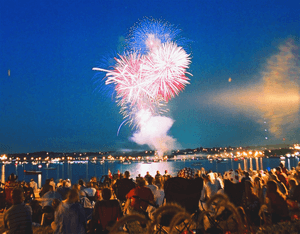
Barrie is home to a number of performing and fine art venues. There are a number of live performance companies including Theatre by the Bay, Talk Is Free Theatre and the Huronia Symphony. Grove Park Home is the practice hall for On-Stage Performance Group which performs in Cookstown. The Strolling Youth Players and the Kempenfelt Community Players also all perform in Barrie. In addition, an annual live concert series is hosted by Georgian College.
Performing arts
There are two main performing arts venues in the city: the Five Points Theatre, and the Georgian Theatre. Originally, the Five Points Theatre was known as The Mady Centre For The Performing Arts, but it was renamed in January 2018. It is located in Barrie's downtown at the Five Points intersection and was completed in 2011. This modern facility is home to many professional and amateur cultural productions, film screenings, theatrical plays, concerts, dance recitals and other performances. It is also the main venue for Theatre by the Bay and the Talk Is Free Theatre Companies. The venue features a flexible stage area with lighting and sound for professional theatre, music, dance, and other presentations, an automated riser/seating system with capacity for 120-200 seats and a sprung performance floor.
The Georgian Theatre is a professional performing arts facility located in Barrie's north end on the campus of Georgian College. The theatre features a proscenium stage, sound, lights, fly gallery and seating for 427 on the main level, with three pods that can be used to increase the seating capacity to 690. The Theatre is used both for theatrical and non-theatrical activity, including conferences and seminars.
Galleries
The prominent MacLaren Art Centre is located in Barrie. This is an art gallery that inspired the "Art City" project, which has had many different large sculptures installed around the city. These can be found in parks and along the waterfront.
Barrie is also home to many independent galleries and studios. A concentration of independent galleries, studios and boutiques is located in Lakeshore Mews. This area is located behind the downtown's Dunlop Street. Lakeshore Mews artists also organize the annual "Arts ce Soir"; an all-night contemporary art event in celebration of visual, musical, theatrical and literary art.
In addition, a studio tour in the Barrie/Orillia area takes place on the Canadian Thanksgiving weekend every year. It is called the Images Studio Tour and has over 25 artists on average. Potters, jewellers, painters, textile artists and fashion designers make up a few of the disciplines of the talents on display.
Festivals
Barrie is home to Kempenfest; one of the largest outdoor arts and crafts celebrations in Ontario. This festival occurs annually over the August long weekend and features over 300 artisans, an antique show, food demonstrations, children's activities and live entertainment, including an indie-music stage.
Since 2021, Barrie has held Open Air Dunlop, in which Dunlop Street downtown is temporarily pedestrianized to attract visitors to the downtown area.
Groups
Some of the main arts and culture groups in the city include:
- Barrie Art Club
- Barrie Concert Band
- Barrie Film Festival
- Barrie Folk Society
- Campus Gallery
- Caribbean Culture Institute
- Huronia Symphony Orchestra
- Kempenfelt Community Players
- King Edward Choir
- Lyrica Chamber Choir
- Simcoe Contemporary Dancers
- Talk Is Free Theatre
- Theatre By The Bay
- Kiwanis
Attractions
Barrie has numerous recreational venues and community centres throughout the city:
- Allandale Recreation Centre
- Barrie Community Sports Complex
- Barrie Public Library
- Dorian Parker Centre
- East Bayfield Community Centre
- Eastview Arena
- Holly Community Centre
- Lampman Park
- Lampman Lane Community Centre
- Parkview Community Centre
- Southshore Community Centre
- Victoria Village
- YMCA of Barrie
- Shak's World Community Centre
Sports
| Club | League | Venue | Established | Championships |
|---|---|---|---|---|
| Simcoe County Rovers | League1 Ontario | J.C. Massie Field | 2022 | 1 |
| Barrie Colts | OHL Hockey | Sadlon Arena | 1995 | 1 |
| Barrie Baycats | IBL Baseball | Vintage Throne Stadium | 2001 | 7 |
| Georgian Grizzlies | OCAA | Georgian College | 1967 | |
| Barrie Sharks | PWHL Hockey | East Bayfield Community Centre | 2011 | 0 |
| Barrie Rugby | ORU Rugby | Jim Hamilton Field | 1967 | 0 |
Barrie is also home to the Mariposa School of Skating, which has trained many world-class figure skaters, including Brian Orser, Elvis Stojko and Jeffrey Buttle.
Transportation
Airports
There are no major airports with scheduled flights near Barrie (the closest being Toronto Pearson International Airport, located in Mississauga). There are a few airports that are used for light aviation aircraft:
- Lake Simcoe Regional Airport
- Barrie/Little Lake Water Aerodrome
- Springwater (Barrie Airpark) Aerodrome
Roads
Barrie is served by Provincial Highway 400, which acts as the primary route between Barrie and Toronto. Highway 400 bisects the city on a roughly north–south basis. Highway 26, also located in the city, is the main route to the Collingwood area and is known as Bayfield Street within the city limits. Barrie was once served by Highway 27, Highway 90, Highway 93, Highway 131 and Highway 11. However, the province downgraded many highways in 1997 and 1998; these highways are now known as Simcoe County Road 27, Simcoe County Road 90 (Dunlop Street), and Simcoe County Road 93.
The portion of Highway 11 through Barrie is known as Yonge Street, though it is actually part of the Penetanguishene Road. Major arterial roads within the city include Mapleview Drive, Ferndale Drive, 10th Line, Big Bay Point Road, Essa Road, Huronia Road, Bayfield Street, Cundles Road, Anne Street, Dunlop Street, Livingstone Street, Duckworth Street, Wellington Street and St. Vincent Street.
Public transit
Public transport is provided by Barrie Transit, which operates numerous bus routes within the city. Accessible transit is offered by booking with city run Barrie Accessible Community Transportation Service. Most regular bus routes operated by Barrie Transit are accessible using low floor vehicles. Barrie also has GO Trains and Buses.
Commuter rail
GO Transit connects the city to the Greater Toronto Area through daily train service along the Barrie line, with trains operating from the Allandale Waterfront GO Station and the Barrie South GO Station. This is primarily a commuter rail service to the GTA, with southbound trips to Toronto's Union Station in the morning rush hour and northbound trips in the evening rush hour. Limited weekend service to and from Toronto is also operated. Barrie was once a stop for the Northlander train but re-routing resulted in the termination of service. The former Barrie station serving the Northlander still exists north of the Allandale GO Station.
Intercity and commuter buses
In addition to train service, GO Transit offers daily commuter-oriented bus service to the Greater Toronto Area. Ontario Northland operates bus routes from various locations to and from Barrie. All inter-urban buses operate from the Barrie Transit Terminal at 24 Maple Street.
Barrie once had been served by various private interurban bus lines such as Penetang-Midland Coach Lines and Greyhound Canada, which ran buses between Barrie and Toronto's Yorkdale Bus Terminal. Greyhound operated QuickLink commuter service from Barrie to Toronto seven days a week. In the past Gray Coach offered service from Toronto to Barrie; the route was later acquired by Greyhound. Greyhound Canada ended all service in Ontario on May 13, 2021.
Barrie is also served by Simcoe County LINX, which provides services between municipalities within Simcoe County, including Orillia, Midland and Penetanguishine.
Passenger rail
Historically, Barrie was served by scheduled passenger rail service. Allandale Station was a stop for the Grand Trunk Railway, Canadian National Railway and Via Rail. In addition, Ontario Northland's Northlander used the station as a stop, as did CN Rail/Via Rail (namely The Canadian). Regular passenger rail service to the station ended in the 1980s and has largely been replaced by regional/commuter rail service.
Education
Barrie has two major English school boards that operate inside the city at a public level. The Simcoe County District School Board administers a public education in Barrie and Simcoe County, while the Simcoe Muskoka Catholic District School Board administers to the Catholic population and serves the Simcoe and Muskoka areas. It also has two French school boards, Conseil scolaire catholique MonAvenir (formerly Conseil scolaire de district catholique Centre-Sud), the Catholic board, and Conseil scolaire Viamonde (CSV, formerly Conseil Scolaire de District du Centre-Sud-Ouest), the secular board. There are also several private schools both for K-8 and K-12.
High schools
- Barrie North Collegiate Institute
- Bear Creek Secondary School
- Eastview Secondary School
- École secondaire catholique Nouvelle-Alliance
- Innisdale Secondary School
- Maple Ridge Secondary School
- St. Joseph's High School
- St. Joan of Arc High School
- St. Peter's Catholic Secondary School
- École secondaire Roméo-Dallaire
- Unity Christian High School
Georgian College
Georgian College's main campus, with over 10,000 full-time students and approximately 25,000 part-time students, is located in Barrie.
Media
Online
Village Media operates BarrieToday.com.
There are both semi-weekly and monthly newspapers serving the City of Barrie. The Barrie Advance, published by Metroland Media Group, is a free newspaper established in 1983 and delivered weekly (on Thursdays) to every residence in the city as well as residents of Springwater Township and parts of Oro-Medonte. The newspaper contains local news, classifieds, advertisements and flyers. Barrie Business is a free newsprint publication covering local and regional business news. Published monthly and distributed to every business in the City of Barrie through Canada Post, it seeks to highlight and support Barrie's local business community and events. The Barrie Examiner, established in 1864, was one of Canada's oldest daily newspapers. It was distributed five days a week (Tuesday to Saturday) to paid subscribers and also delivered to the remainder of the market free on Thursdays. The Examiner was one of several Postmedia Network newspapers purchased by Torstar in a transaction between the two companies in 2017. Following the acquisition, Torstar subsidiary Metroland Media Group announced the closure of the paper effective November 27, 2017.
Radio
Local radio stations serving Barrie and area include:
| Frequency | Call sign | Branding | Format | Owner | Notes |
|---|---|---|---|---|---|
| FM 93.1 | CHAY | Fresh Radio | Hot adult contemporary/Top 40 | Corus Entertainment | |
| FM 95.7 | CFJB | Rock 95 | active rock | Central Ontario Broadcasting (Rock 95 Broadcasting (Barrie-Orillia) Ltd.) | |
| FM 98.5 | CKEY-FM | tourist information | Douglas George Edwards | CKEY-FM, Tourist, Barrie - Canadian Communications Foundation CKEY-FM Barrie, ON - fccdata.org | |
| FM 100.3 | CJLF | Life 100.3 | Christian radio | Trust Communications Ministries, Inc. | |
| FM 101.1 | CIQB-FM | Big FM | Classic Hits | Corus Entertainment | |
| FM 106.7 | CFRH-FM-1 | Community radio (French) | Radio-Huronie(La Clé d'la Baie en Huronie, Association Culturelle Francophone) | Rebroadcaster of CFRH-FM Penetanguishene | |
| FM 107.5 | CKMB-FM | Kool FM | Hot adult contemporary | Central Ontario Broadcasting (Rock 95 Broadcasting (Barrie-Orillia) Ltd.) |
Other radio stations from Orillia, Midland, Newmarket, Toronto and the surrounding areas can also be heard in Barrie.
Television
CKVR-DT (currently part of the CTV 2 television system) is the only local television station in Barrie. It produces approximately 1.30 hours of local news on weekdays and 1 hour of local news on weekends.
Television stations and rebroadcasters based in the vicinity of Barrie Region are:
| OTA virtual channel (PSIP) | OTA channel | Rogers Cable | Call Sign | Network | Notes |
|---|---|---|---|---|---|
| 3.1 | UHF | 10 | CKVR-DT | CTV 2 | |
| 7.1 | 7 | 3 | CIII-DT | Global Television Network | |
| – | – | 10 | – | Rogers TV | Community channel for Rogers Cable
subscribers |
Notable people
- Brent Burns (born 1985), professional ice hockey defenceman for the Carolina Hurricanes
- Matthew Di Leo (born 1995), racing driver
- Mark Dilley (born 1969), racing driver
- Mitchell Hooper (born 1995), strongman and winner of 2023 World's Strongest Man
- Rebecca Hornbrook (born 1975), atmospheric chemist at the National Center for Atmospheric Research
- Michael Hutchinson (born 1990), professional ice hockey goaltender
- Gordon Meeking (born 1890), retired NHL player
- Slava Pastuk (born 1990), music journalist and author of Bad Trips
- Darrin Shannon (born 1969), retired NHL player
- Darryl Shannon (born 1968), retired NHL player
- Daniel Vandervoort (born 1994), CFL wide receiver
- Samantha Win (born 1991), actress and martial artist
See also
 In Spanish: Barrie para niños
In Spanish: Barrie para niños


